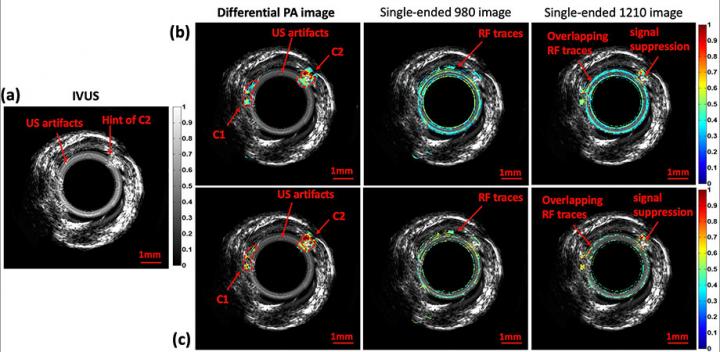New imaging modality targets cholesterol in arterial plaque

Figure 11: (a) Normalized 14-MHz IVUS image of the atherosclerotic artery phantom by IVUS at 14-MHz. (b) Normalized PAR amplitude and (c) phase images of IV-DPAR, single-ended 980-nm PAR and singleended 1210-nm PAR modes. The same endoscopic transducer and instrumentation were shared by IVUS and IV-DPAR for coregistration. C1, Cholesterol sample 1 and C2, Cholesterol sample 2. Credit: Sung Soo Sean Choi et al.
In an article published in the peer-reviewed SPIE publication Journal of Biomedical Optics (JBO), “Frequency-domain differential photoacoustic radar: theory and validation for ultra-sensitive atherosclerotic plaque imaging,” researchers demonstrate a new imaging modality that successfully identifies the presence of cholesterol in the arterial plaque.
Cholesterol in plaque, along with fat, calcium, and other blood-transported substances, can lead to atherosclerosis, a disease which can cause heart attacks or strokes. Early detection of cholesterol can lead to earlier treatments and improved health outcomes.
Toronto-based researchers have demonstrated a unique detection technique that combines laser photoacoustics, a hybrid optical-acoustic imaging technology, with low-power continuous wave lasers and frequency-domain signal processing, in an approach known as photoacoustic radar.
This advanced technology can accurately evaluate plaque-based cholesterol, and allow for more timely treatment of atherosclerosis.
According to JBO Editor-in-Chief, SPIE Fellow, and MacLean Professor of Engineering at the Thayer School of Engineering at Dartmouth College, New Hampshire, Brian Pogue, the findings mark an exciting new direction in imaging:
“This is an original direction of imaging research that utilizes an innovative idea of detection based upon differences between wavelengths, and signal analysis based upon radar methods. Photoacoustic imaging has the best potential for imaging through thick tissues or blood: the high-sensitivity detection of cholesterol described in this paper is made possible with a specifically modified, dual wavelength approach.”
###
The article authors are Sung Soo Sean Choi, a PhD candidate at the University of Toronto; Bahman Lashkari, a research associate at the University of Toronto; and Andreas Mandelis, a professor of mechanical and industrial engineering and of electrical and computer engineering at the University of Toronto; Jungik Son, Natasha Alves-Kotzev, and Stuart F. Foster of the Sunnybrook Research Institute of Toronto; and Mark Harduar of Conavi Medical, Toronto; and Brian Courtney of both Sunnybrook Research Institute and Conavi Medical.
JBO, an open-access journal, is published in print and digitally by SPIE in the SPIE Digital Library, which contains more than 500,000 publications from SPIE journals, proceedings, and books, with approximately 18,000 new research papers added each year.
About SPIE
SPIE is the international society for optics and photonics, an educational not-for-profit organization founded in 1955 to advance light-based science, engineering, and technology. The Society serves 257,000 constituents from 173 countries, offering conferences and their published proceedings, continuing education, books, journals, and the SPIE Digital Library. In 2018, SPIE provided more than $4 million in community support including scholarships and awards, outreach and advocacy programs, travel grants, public policy, and educational resources. http://www.
Contact:
Daneet Steffens
Public Relations Manager
daneets@spie.org
+1 360 685 5478
@SPIEtweets
Media Contact
More Information:
http://dx.doi.org/10.1117/1.JBO.24.6.066003All latest news from the category: Medical Engineering
The development of medical equipment, products and technical procedures is characterized by high research and development costs in a variety of fields related to the study of human medicine.
innovations-report provides informative and stimulating reports and articles on topics ranging from imaging processes, cell and tissue techniques, optical techniques, implants, orthopedic aids, clinical and medical office equipment, dialysis systems and x-ray/radiation monitoring devices to endoscopy, ultrasound, surgical techniques, and dental materials.
Newest articles

A ‘language’ for ML models to predict nanopore properties
A large number of 2D materials like graphene can have nanopores – small holes formed by missing atoms through which foreign substances can pass. The properties of these nanopores dictate many…

Clinically validated, wearable ultrasound patch
… for continuous blood pressure monitoring. A team of researchers at the University of California San Diego has developed a new and improved wearable ultrasound patch for continuous and noninvasive…

A new puzzle piece for string theory research
Dr. Ksenia Fedosova from the Cluster of Excellence Mathematics Münster, along with an international research team, has proven a conjecture in string theory that physicists had proposed regarding certain equations….



